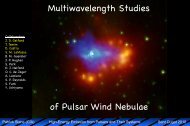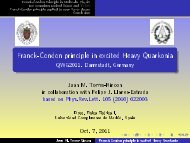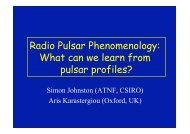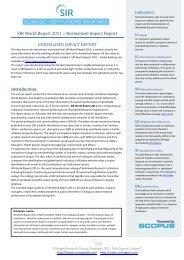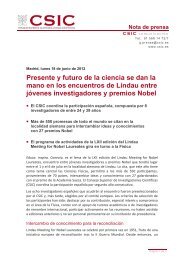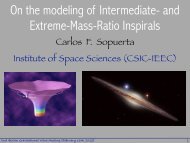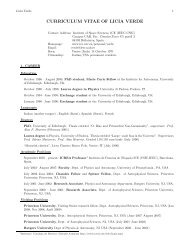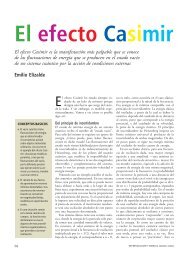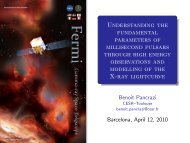Gamma-ray binaries as non-accreting pulsar systems
Gamma-ray binaries as non-accreting pulsar systems
Gamma-ray binaries as non-accreting pulsar systems
- No tags were found...
Create successful ePaper yourself
Turn your PDF publications into a flip-book with our unique Google optimized e-Paper software.
<strong>Gamma</strong>-<strong>ray</strong>s from <strong>binaries</strong>: GeV and TeV *See Cortina’s and Dubois’s talks in this conferencefor observational results in the TeV and GeV domain. *See Stella’s for a MW overview. LS I +61 303 Average spectrum:Index: 2.21, Cutoff: 6.3 GeVLS 5039 Average spectrum:Index: 1.9, Cutoff: 2.1 GeV2
<strong>Gamma</strong>-<strong>ray</strong>s from <strong>binaries</strong> and gamma-<strong>ray</strong> <strong>binaries</strong> • gamma-<strong>ray</strong> <strong>binaries</strong>:when gamma-<strong>ray</strong> emission above 10 MeV dominates the SED output • This is the c<strong>as</strong>e for LS 5039, PSR B1259-63, LSI+61 303 • This is not the c<strong>as</strong>e for Cyg X-1 (for which L vhe ~ 10 -4 L x )• Other clear distinctive phenomenology: orbital variability vs. flaresPlot from Chernyakova et al. 2006 LS I +61 303 3
Dichotomy in composition Plot from Mirabel 2006 4
A few ide<strong>as</strong> on gamma-<strong>ray</strong> generation from <strong>pulsar</strong> <strong>binaries</strong> Models do share generic ingredients • Binary system with m<strong>as</strong>sive star(giving target material, photons: essentially anisotropicIC models)• Binary orbit constrain geometry in <strong>non</strong>-trivial ways • Other radiative processes:Synchrotron / absorption & pair creation / c<strong>as</strong>cading Different dominance: -<strong>pulsar</strong> wind zone processes (e - accelerated by <strong>pulsar</strong> or inter-windshocks or particle energization in theinner wind already produced gammaemission therein) -shock processes (e - accelerated by inter-wind shock,interact in the MSWZ) Ide<strong>as</strong> go back to Mar<strong>as</strong>chi and Treves 1981; Protheroe and Stanev 1987, Arons and Tavani 1993, 1994; Tavani & Arons 1997; Bednarek 1997; Kirk et al. 1999; … 5
A few ide<strong>as</strong> on gamma-<strong>ray</strong> generation from <strong>pulsar</strong> <strong>binaries</strong> Models do share generic ingredients • In a variable geometry along the orbit• Pulsar (or close-to-psr shock) inject electrons • Which interact via (anisotropic, KN) IC • Photons are absorbed and initiate c<strong>as</strong>cades • Which are computed by Monte Carlo or othermethods Things to note from geometry e.g. for LS 5039 • Detailed account of processes in a varyinggeometry, plus full analysis of c<strong>as</strong>cading Plots from Sierpowska-Bartosik & DFT 2008 6
A few ide<strong>as</strong> on gamma-<strong>ray</strong> generation from <strong>pulsar</strong> <strong>binaries</strong> Opacities are very dependent on ph<strong>as</strong>e, and their combined role generate LC and spectra Different energies, same inclinationDifferent inclinations, same energiese.g. for LS 5039 Left plots from Dubus 2006, Right plots from Sierpowska-Bartosik & DFT 2008 7
A few ide<strong>as</strong> on gamma-<strong>ray</strong> generation from <strong>pulsar</strong> <strong>binaries</strong> Anti-correlation of GeV and TeV fluxes is a sustained prediction of these models(<strong>as</strong> a result of physical process and the geometry, less of the possible <strong>pulsar</strong> in the system) Left: Bednarek 2006 Right: Aharonian et al. 2006 [Probably all in place since Protheroe &Stanev 1987. It w<strong>as</strong> also found by Dubus et al. 2008 Sierpowska-Bartosik & DFT 2007, 2008b] and others working in black hole models. Prediction of orbital spectral variation in the GeV range is also overall ok (e.g., at the hardness ratio level) 8
A few ide<strong>as</strong> on gamma-<strong>ray</strong> generation from <strong>pulsar</strong> <strong>binaries</strong> Other good and bads: -No model predicted the Fermi GeV cutoffs (nor the ones withBHs) Comparison between LS and LSI: LS I opacities in the PWZ a factor offew-to-few-10 lower than in LS -Models predicted less flux than observed (not dramatic, andespecially, not true at the tens of GeV range) -PWZ and Shock models are not exclusive (ultimatelydepending on opacities, hybrid models not in place, manyparameters) -<strong>Gamma</strong>-<strong>ray</strong> <strong>as</strong>tronomy <strong>as</strong> a window for the study of <strong>pulsar</strong>windsThe emission of the unshocked wind isincompatible with observations whenthe former is formed by monoenergeticparticles. Plots from Cerutti et al 2009, Sierpowska-Bartosik & DFT 2008, 2009 9
Why is a <strong>non</strong>-<strong>accreting</strong> <strong>pulsar</strong> a tenable alternative? 1) The m<strong>as</strong>s function is compatible with a <strong>pulsar</strong> binary • The m<strong>as</strong>s function values are low. See J. C<strong>as</strong>ares’s talk • If ignorance of the orbital inclination can be represented by a random distribution, thelikelihood for the system to be formed by a neutron star is greater than to be formed bya black hole compact object. C<strong>as</strong>ares et al. (2005a,b); Grundstrom et al. (2007); Aragona et al (2009) 10
Why is a <strong>non</strong>-<strong>accreting</strong> <strong>pulsar</strong> a tenable alternative? (II) 2) No obvious sign of accretion See next slides for the search of lines • LSs are in the lower-end of the HMXB distribution of X-<strong>ray</strong> luminosities, albeit stillcompatible with some wind-fed <strong>accreting</strong> <strong>binaries</strong>. • If Bondi accretion: The accretion rate is dM=dM w /(2r a /d s ) 2 ~ 5×10 14 g s −1 [wheredM w is the stellar wind m<strong>as</strong>s loss rate, d s is the orbital separation, and r a = 2GM c /v w2is the Bondi capture radius, with M c the m<strong>as</strong>s of the compact object and v w thewind speed], that when transformed into power implies unrealistic efficiencies.• No variability on s-scales, <strong>as</strong> low/hard state LMXRB or disc <strong>accreting</strong> HMXB.• No sign of a corona in X-<strong>ray</strong>s, instead, there is an apparent lack of spectralcutoffs at 30 keV to 100 keV, distinguishing these <strong>systems</strong> from both <strong>accreting</strong>HMXBs and low state LMXBs. • To avoid disc accretion, if all of the <strong>pulsar</strong> spin-down power L sd is transferred tothe <strong>pulsar</strong> wind, pressure equality implies L sd > 4(dM)v w c. Writing L sd <strong>as</strong> functionof P and B, it results P < 230 B 1/2 (dM/10 15 g s -1 ) −1/4 ms,• If a f<strong>as</strong>t (young) millisecond <strong>pulsar</strong> is present, accretion onto it is not expected. e.g., Chernyakova, Neronov & Walter 2006; Takah<strong>as</strong>hi et al. 2009, Rea et al. 2010 11
Why is a <strong>non</strong>-<strong>accreting</strong> <strong>pulsar</strong> a tenable alternative? (III) 3) It is ok not to see radio-pulses (opacities too large) • The opacity to free-free absorption in the equatorial disc of the star in LS I 61 303(using fiducial values) is • This absence of radio pulses also happens in the peri<strong>as</strong>tron of PSR B 1259-63 • In the polar flow of the star, the opacity is also high (f gives a me<strong>as</strong>ure of clumpiness) e.g., Zdziarski, Neronov & Chernyakova (2008) 12
Why is a <strong>non</strong>-<strong>accreting</strong> <strong>pulsar</strong> a tenable alternative?4) The radio morphology is stable and no jets are seen in any scale Simultaneous radio-morphology at different angular resolution • The size of the radio emitting region of LS I +61 303 is less than 6 m<strong>as</strong> (12projected AU), and the presence of persistent jets above this scale is excluded. • The comparison of VLBA images at similar orbital ph<strong>as</strong>es, but 10 orbital cycles apartshows a high level of similarity • Interaction of steady flows (from a relativistic <strong>pulsar</strong> wind, jet and/or stellar wind) ratherthan by the interaction of such an outflow with wind clumps. • If radio emission is produced by a milli-arcsecond scale jet, its stability and periodicity isdifficult to reconcile with the <strong>non</strong>-persistent nature of a large scale feature LS I +61 303 on 25-26/10/2006, ph<strong>as</strong>e 0.62e.g., Dhawan et al. 2006, Albert et al. 2009; ; there is a similar radio morphology in LS 5039, see Ribó 2008 13
Why is a <strong>non</strong>-<strong>accreting</strong> <strong>pulsar</strong> a tenable alternative?4) The radio morphology is stable and no jets are seen in any scale Non-trivial radio morphology is expected in <strong>pulsar</strong> <strong>binaries</strong> (cometary tails are evenproduced in interactions with the ISM for isolated <strong>pulsar</strong>s) • Where<strong>as</strong> on a small scale, the shocked material flows away from the binary on <strong>as</strong>traight path, following the direction given by the vector difference of the stellar windand orbital speeds v w − v orb ; on a larger scale, the material shears with the orbitalmotion Top: simulations by Dubus 2006 Bottom observations by Paredes et al 2000 e.g., Dubus 2006, observation by Paredes et al. 2000 14
Why is a <strong>non</strong>-<strong>accreting</strong> <strong>pulsar</strong> a tenable alternative?4) Young ages are consistent • Tracing back of the proper motion places upper limit to the age (e.g. Ribó 2002) 5) Pulsar <strong>systems</strong> would be consistent with population predictions of Be XRBs • 64 Be XRBs are known, and in 42 the compact object w<strong>as</strong> confirmed to be a neutronstar by the presence of the X-<strong>ray</strong> pulsations; in not a single one of them, a black holew<strong>as</strong> confirmed (these are older <strong>pulsar</strong>s, only a few are expected to host a young psr) • An evolutionary effect? The rotation of Be stars could be achieved during a period ofRoche-lobe overflow from the more m<strong>as</strong>sive compact object progenitor, and if it loosesmost of the m<strong>as</strong>s in the early pre-SN ph<strong>as</strong>e process, becoming a He star with m<strong>as</strong>s ofonly a few M ⊙ , when exploding <strong>as</strong> a supernova it can only leave a neutron star behind e.g., Belczynski & Ziolkowski 2009; Tauris & van den Heuvel 2006 15
X-<strong>ray</strong> variability in gamma-<strong>ray</strong> <strong>binaries</strong>LS I +61 303 95 ks Chandraobservation near ap<strong>as</strong>tron 1ks binning lightcurves in fivetime intervals Bkg. Subtracted (0.3-10 keV)lightcurve binned at 100s • On top of a slow variability of a factor of 2, there were 2 flares l<strong>as</strong>ting 3 and 1.5 ks• Not unseen in this source: Sidoli et al. 2006; Paredes et al. 2007; Esposito et al. 2007; Smith et al. 2009 have found some similar flares From Rea, DFT, van der Klis, Jonker, Mendez, Sierpowska-Bartosik 2010 16
Do we understand these flares in <strong>pulsar</strong> models? LS I +61 303 • Variability not observed in isolated <strong>pulsar</strong>s • In an accretion scenario, flares like these can be explained by variability in theaccretion rate• In the rotational-powered <strong>pulsar</strong> scenario, <strong>as</strong> the interaction between the <strong>pulsar</strong>wind and clumps in the Be wind. If the typical density of a clump in the wind is n 10 10 cm −3 and its size is R 10 11cm, then δNH n R 10 21 cm −2 . The strong dependence between NH, Γ and thepower-law normalization, intrinsinc to the power-law modeling, might hide thisvariability in an incre<strong>as</strong>e of the hardness of the emission Neronov & Chernyakova. et al. 2007 17
Shorter timescales variability resembling a magnetar?• On 2008 September 10th, Swift-BAT triggered on a short SGR-like burst from the direction of LS I +61 303. • The other telescope onboard, Swift-XRT did not detect the burst because started observing 921s after the BAT trigger. • The burst location, lightcurve, duration, fluence, and spectra were fully consistent with a SGR/AXP • Archival analysis of Chandra ACIS-I observation showed many faint sources in the field of view, some with VLAdetections (16 compact radio sources within a 10 arcmin field of view with a peak flux density above four times the rmsnoise). • Magnetars are not <strong>as</strong>sociated with compact radio sources.• Thus, any X-<strong>ray</strong> source without a radio counterpart within the field of view could be the origin of the burst.GCN 8209, 8211, 8215; ATELs 1715,1731, 174018
Accretion signatures in gamma-<strong>ray</strong> <strong>binaries</strong>? • The presence of spectral lines is highly dependent on the continuum spectrum and on theorbital ph<strong>as</strong>e of the system. • The best data available for these kind of studies come e.g., from the XMM-Newtonsatellite (large collecting area, spectral resolution, grating spectrometer).• However, at a given orbital ph<strong>as</strong>e, only very short observations have been taken (aiming atmonitoring the continuum spectral variability over the orbit).• In the p<strong>as</strong>t XMM-Newton spectra of, e.g, LS 5039, an EW 60 eV is the current 1σlimit on the presence of Fe Kα (and only in a small part of the orbit). In the availableSuzaku observations, the limit on the detection of lines is 40 eV (see Takah<strong>as</strong>hi et al.2009).• With the current short pointings (at a given orbital ph<strong>as</strong>e) there are not enough counts to usethe high-resolution spectral capabilities. 19
Accretion signatures: a word of caution • Consider the binary 4U 1700-37,• A very similar HMXB to LS 5039 (i.e., similar companion star and 4-days orbitalperiod, but no TeV emission, and clearly <strong>accreting</strong>) located at 1.5 kpc • Left: XMM-Newton spectrum of 4U 1700-37 (first published by van der Meer et al. 2005). • Right: how would these accretion lines look, <strong>as</strong>suming all are present, in the available datafor LS 5039 LS 5039 15 ks XMM simulationof the response of anspectrum full withaccretion lines 20
Pulsation search • Deep searches for pulsations have been performed in the radio band at several frequencies.However, no radio pulsations have been detected so far from candidates. • At PSR B1259–63’s peri<strong>as</strong>tron there is no radio pulsation. Its peri<strong>as</strong>tron (given thelarge orbit, 3.4 year period) is approximately the same size than the major axis of theorbit of LS I +61 303 (26 days period) and it is way larger than LS 5039’s obit (4 daysperiod). • The strong m<strong>as</strong>sive companion winds might have prevented radio pulsations to be detectedbecause of the strong free-free absorption all over the orbits.• PSR B1259-63 does not show X-<strong>ray</strong> pulsation either in the peri<strong>as</strong>tron (~15% pulsedfraction).• X-<strong>ray</strong> emission not-magnetospheric dominated? • beam not well-pointed? • A clearly difficult game, hopefully to be aided by GeV observations. 21
Pulsation X-<strong>ray</strong> search: the current status LS I +61 303 Pulsed fraction 3σ UL on the semiamplitudeof a sinusoidal signal95 ks Chandraobservation near ap<strong>as</strong>tron 0.3 – 2 keV Overall similar situation: 2 – 4 keV • Search for periods with frequencies 0.005 – 175 Hz (timingresolution of the CC-mode: 0.00285 s) • Pulse fraction upper limits between 7 – 15 % for the wholeenergy range (larger in smaller energy bands) 4 – 10 keV • No significant short bursts in bins of 0.1 s from Rea, DFT, van der Klis, Jonker, Mendez, Sierpowska-Bartosik 2010 22
Pulsation X-<strong>ray</strong> search: the current status (II)LS 5039 ~100 ks Chandra But given the size of the orbit of LS 5039 <strong>as</strong> compared with LSI +61 303, we do not expect much difference in the results. ? from Rea, DFT, van der Klis, Jonker, Mendez, Sierpowska-Bartosik 2010b; in preparation23
The GeV Fermi data in perspective LS I +61 303 Average spectrum:Index: 2.21, Cutoff: 6.3 GeVLS 5039 Average spectrum:Index: 1.9, Cutoff: 2.1 GeV• The Fermi PSR catalog h<strong>as</strong> 46 high confidence <strong>pulsar</strong> detections. The <strong>pulsar</strong> spectra is fitted withan exponentially cutoff power-law model, with the large majority of the cutoff values being < 3 GeV. • Exponential cut-offs are reminiscent of the Fermi <strong>pulsar</strong> spectra; is this a sign of magnetosphericemission in these <strong>systems</strong>? But the orbital variability of spectrum? From the spectral viewpoint, it makes sense to <strong>as</strong>k What if the gamma-<strong>ray</strong> <strong>binaries</strong> are part of the same populationand the GeV emission is coming from the <strong>pulsar</strong> magnetospheres? See Abdo et al. 2009a,b for the Fermi results on <strong>binaries</strong> 24
The problem and a hypothesis towards its solution PSR • GeV-emissionpulsed • Cutoff is abalance btwacceleration/curvature loss Unpulsedradiation.Why? • Not enoughstatistics • W<strong>as</strong>hed out inuncertainorbitalparameters Orbitalvariation? • Curvatureemissionproduced near<strong>pulsar</strong> • No obviousre<strong>as</strong>on formodulation The spectral distribution points to a natural <strong>pulsar</strong> interpretation of the GeV emission, but the orbitalvariability argues against it, and overall, the GeV-TeV anti-correlation remains unexplained.The 2-components GeV flux hypothesis GeV emission is formed by both a magnetospheric component, pulsed, steady along the orbit, plusan inter- or intra-wind shock component, unpulsed, modulated with the orbital motion. TeV emission is only formed by the modulated signal, having the pulsed component died out atsuch energies. 25
Could it work? Total SUPC emission Total INFC emission PWZ/Shock SUPC contribution PWZ/Shock INFC contribution Pulsed emission Lines do not represent a model, just the idea 26
Could it work? Total SUPC emission Total INFC emission PWZ/Shock SUPC contribution PWZ/Shock INFC contribution Pulsed emission Lines do not represent a model, just the idea 27
Could it work? Total SUPC emission Total INFC emission PWZ/Shock SUPC contribution PWZ/Shock INFC contribution Pulsed emission Lines do not represent a model, just the idea 28
Could it work? Total SUPC emission Total INFC emission PWZ/Shock SUPC contribution PWZ/Shock INFC contribution Pulsed emission Lines do not represent a model, just the idea 29
Could it work? Total SUPC emission Total INFC emission PWZ/Shock SUPC contribution PWZ/Shock INFC contribution Pulsed emission Lines do not represent a model, just the idea 30
Could it work? Total SUPC emission Total INFC emission PWZ/Shock SUPC contribution PWZ/Shock INFC contribution Pulsed emission Lines do not represent a model, just the idea 31
Could it work? Total SUPC emission Total INFC emission PWZ/Shock SUPC contribution PWZ/Shock INFC contribution Pulsed emission Lines do not represent a model, just the idea 32
Could it work? Total SUPC emission Total INFC emission PWZ/Shock SUPC contribution PWZ/Shock INFC contribution Pulsed emission Lines do not represent a model, just the idea 33
Could it work? In this proposal it is possible to expect• the anti-correlation of GeV-TeV fluxes,• a possible incre<strong>as</strong>e of the energy (or disappearance!) of the GeV me<strong>as</strong>ured exponential cutoff(this would explain why there is no cutoff in LS 5039 INFC; high cutoff in LS I +61 303) and provides an interpretation for • why Fermi sees spectral <strong>pulsar</strong>-like spectra which varies with the orbital ph<strong>as</strong>e: it is just an effectof when, which contribution significantly contribute to the total flux.• makes it even harder to see the pulsation in GeV data (the pulsed fraction is only a fraction of theflux observed) In addition: • makes the INFC (maximum of TeV, minimum of GeV) the best place to look for pulsations (thepulsed fraction is the highest)34
Are we far? Color lines are PWZ models, <strong>as</strong> in Sierpowska-Bartosik & DFT 2008 The <strong>pulsar</strong> model is a typical Fermi spectrum, added ad-hoc. 35
Concluding remarks -Ground-b<strong>as</strong>ed Cherenkov ar<strong>ray</strong>s and Fermi have confirmed that <strong>binaries</strong> are sources of HE/VHEgamma-<strong>ray</strong>s. -High m<strong>as</strong>s companions influence lead to orbital VHE modulation (absorption & c<strong>as</strong>cadinginvolved) -Binary plerions are a new window for <strong>pulsar</strong> wind physics.-All in all, the possibility of <strong>pulsar</strong>-composed gamma-<strong>ray</strong> <strong>binaries</strong> remain <strong>as</strong> viable theoretical andphenomenological alternative, if not the preferred one b<strong>as</strong>ed on MW observations -But it is not a proven one yet.-Future experiments in the 10-100 GeV range are crucial to disentangle model features -We need more <strong>binaries</strong> to play. Thank you! 36
Accretion signatures: the current statusLS I +61 303 95 ks Chandraobservation near ap<strong>as</strong>tron For the total spectrum, the 3σ upper limit on theequivalent width of the presence of lines range between50 − 550 eV depending on the energy (between 0.3–10keV) and <strong>as</strong>sumed line width (σ E = 0.05 − 0.5 keV).Spectra of the 5 time intervals fitted with an absorbed power-law function and 1σ sensitivity for thepresence of spectral lines (defined <strong>as</strong> the 1σ limit for the detection of flux variability on top of thecontinuum model <strong>as</strong> a function of energy, lines <strong>as</strong> broad <strong>as</strong> the energy-dependent instrument resolution). from Rea, DFT, van der Klis, Jonker, Mendez, Sierpowska-Bartosik 2010 38
<strong>Gamma</strong>-<strong>ray</strong> pulsation limits in context • X-<strong>ray</strong> pulsations from rotational powered <strong>pulsar</strong>s have been detected in tens of objects, ofwhich only fourteen are to date also TeV emitters (see e.g. Mattana et al. 2009), due to thepresence of an energetic Pulsar Wind Nebula (PWN).Features of isolated rotational-powered X-<strong>ray</strong> emitting <strong>pulsar</strong>s Rotational powerPulsation period Characteristic ages Magnetic fieldsX-<strong>ray</strong> pulsed fractionsRange for physical value 3 × 10 35 < L sd < 5 × 10 38 erg s −1 33 < P < 326 ms 0.7 < τ c < 90 kyr 10 12 < B < 5 × 10 13 Gauss >18 % • A PF < 15% for spin periods <strong>as</strong> f<strong>as</strong>t <strong>as</strong> 5.6 ms (much f<strong>as</strong>ter than the f<strong>as</strong>test rotationalpowered <strong>pulsar</strong> known to be a TeV emitter), indicates that if the compact object hosted is arotational-powered <strong>pulsar</strong>, its X-<strong>ray</strong> emission cannot be dominated by synchrotron emissionfrom the <strong>pulsar</strong> magnetosphere alone… or the beam is really mis-pointed.See Mattana et al. 2009 for a compilation of physical values 39
Why is a <strong>non</strong>-<strong>accreting</strong> <strong>pulsar</strong> a tenable alternative?4) The radio morphology is stable and no jets are seen in any scale 4a) A <strong>pulsar</strong>-wind like feature? • No large features or high-velocity flows were noted in any of the observing days,which implies at le<strong>as</strong>t its <strong>non</strong>-permanent nature.• The changes within 3 hours were found to be insignificant, so the velocity of theoutflow can not be much over 0.05c. • The position and direction of the cometary tail can be understood if the <strong>pulsar</strong> movesin a dense, slow equatorial wind LS I +61 303 e.g., Dhawan et al. 2006, Albert et al. 2009, montage on the right by Dubus 2008; there is a similarly changing radio morphology in LS 5039, see Ribó 2008 40



